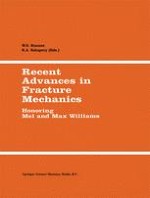1998 | OriginalPaper | Chapter
Nonsteady crack and craze behavior in PMMA under cyclical loading: II. Effect of load history on growth rate and fracture morphology
Authors : Guillermo C. Pulos, Wolfgang G. Knauss
Published in: Recent Advances in Fracture Mechanics
Publisher: Springer Netherlands
Included in: Professional Book Archive
Activate our intelligent search to find suitable subject content or patents.
Select sections of text to find matching patents with Artificial Intelligence. powered by
Select sections of text to find additional relevant content using AI-assisted search. powered by
This is the second of three papers devoted to time or frequency effects on crack propagation in PMMA under cyclic loading with high resolution measurements of crack and craze growth in the micron range and with subcycle temporal resolution. It is demonstrated that the breakdown rate of the craze leads to quasi-periodic spurts of propagation and growth retardation in dependence on both the magnitude of the stress intensity factor and on the imposed load frequency. The surface morphology is governed more by the time required to build and deteriorate the craze (process time) than by the amplitude of the stress intensity factor.Three different growth ranges are distinguished: At the highest load levels (K ≈ 1 MPa m1/2) multiple crazes occur at various distances from the major crack plane which coalesce and give rise to an incoherent surface structure not characterizable in terms of a single craze, although the front of the craze/crack is still represented by a smooth curve; crack advance occurs over domains that are larger than a typical craze length. At lower stress levels (K ≈ 0.6 MPa m1/2) the craze breaks at different levels within the craze structure, the spatial breakdown of the craze being limited to dimensions smaller than the craze length but with a correlation or memory effect that generates terraces (on the fracture surface) on a scale larger than the craze length. In a transition between this stage and the lowest stress level considered, both features may exist simultaneously on a fracture surface, one increasing or decreasing relative to the other. Increase/decrease of one phenomenon relative to the other does not occur at a fixed stress intensity range but depends on the past history. When a change in the loading produces a change in the fracture mode, it is possible to associate, during the transition, decreasing crack growth rates with increasing stress intensity factors. At the lowest loading (K ≈ 0.35 MPa m1/2) a craze breaks essentially through its center leaving a submicroscopically smooth surface; the associated crack growth and craze break down occurs with more or less periodic increments that are each smaller than the full ‘equilibrium’ craze length.
